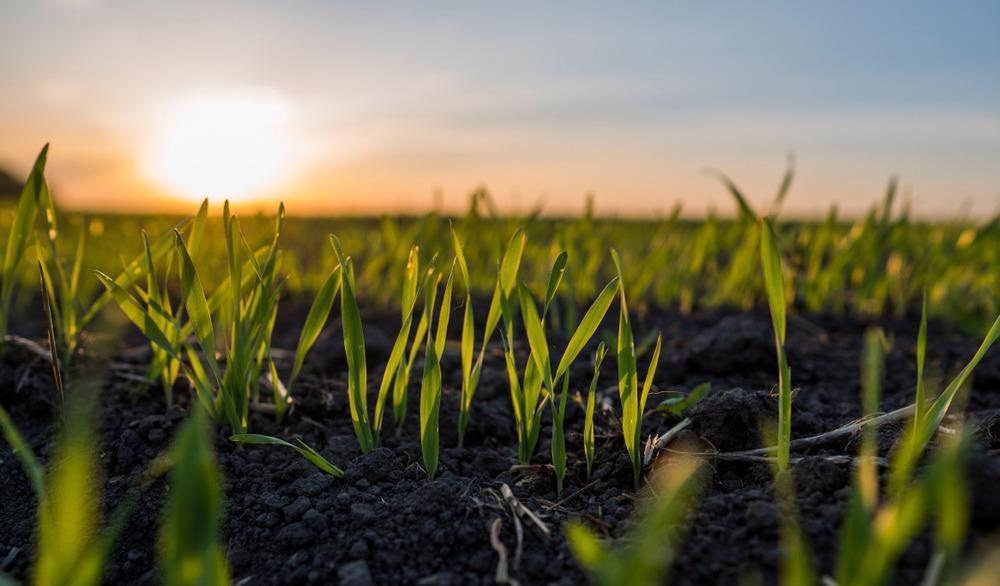Available in the journal Environmental Science and Technology, scientists have investigated the effect of dissolved organic matter (DOM) released from agricultural organic inputs like biochar, livestock manure, and straw, on the transport of nanoplastics in porous media containing iron.

Study: Effect of Agricultural Organic Inputs on Nanoplastics Transport in Saturated Goethite-Coated Porous Media: Particle Size Selectivity and Role of Dissolved Organic Matter. Image Credit: Volodymyr_Shtun/Shutterstock.com
Effect of Nanoplastics on the Environment
The adverse effect of microplastics (MPs) in water has become a global concern.
Several studies have indicated that agricultural film crushing, sewage irrigation, atmospheric precipitation, organic fertilization, and surface runoff can present microplastics into farmlands. According to a report, the annual input of MPs to farmland soil is much higher compared to the ocean.
In farmland soil and ocean, MPs degrade via chemical decomposition or biodegradation into nanoplastics, which possess different characteristics owing to their smaller size. Nanoplastics have greater biological toxicity and, hence, it is important to study them to understand their environmental fate.
Previous studies have indicated that the size of the nanoplastics is the most important influencing factor; this is because their larger size can be retained easily in the sand by the formation of small barriers or agglomeration.
Scientists have reported that the presence of iron (Fe) oxide enhances the deposition of large size nanoplastics. The organic inputs used on agricultural land affect the ecological processes of the soil and influence the fate of its pollutants.
Organic Inputs and Nanoplastics
Needless to say, organic inputs are eco-friendly and sustainable fertilizers that significantly enhance crop productivity and improve soil quality.
Importantly, DOM released from organic inputs, adsorb on clay minerals, Fe oxides, and the surface of nanoparticles. This results in considerable alteration of the surface chemistry and retention−repulsion properties of the water−sand−nanoparticle system.
The current report highlights the importance of DOM in soils in regulating the transport of nanoparticles and colloids.
Prior studies have indicated some factors, such as humification, size, and morphology of DOM and humic acid (HA), influence the transport of ferrihydrite nanoparticles. For instance, a large NP leads to a reduced heteroaggregation rate of nanoplastics with DOM.
Scientists stated that more research is required to elucidate the microinterfacial mechanism of nanoplastics under similar conditions, which is analogous to actual farmland soil, especially, considering the effect of organic input and DOM.
Effect of Agricultural Organic Inputs on Nanoplastics Transport in Saturated Goethite-Coated Porous Media - A New Study
Scientists investigated the effect of DOM released from agricultural organic inputs on the transport of nanoplastics in porous media containing Fe. They further studied the mechanism associated with the microinterfacial interaction among DOM, goethite, and nanoplastics using column experiments.
The authors of this study stated that their findings would improve the understanding of nanoplastics mobility in the agricultural ecosystem.
In this study, researchers simulated results of nanoplastics transport with different sizes ranging between 50(50nanoplastics) and 400(400nanoplastics) nm in sand or goethite (GT)-coated sand columns.
It was observed that the transport of 50nanoplastics decreased with increasing GT content, which was more evident in fine sand. This was indicated by a considerable reduction in the recovery rate. Also, researchers observed that elevation in the nanoplastics size and Fe mineral content resulted in a reduction of nanoplastics transport.
A 0.2% GT content significantly reduced 400nanoplastics transport in coarse and fine sand columns. This finding implies that GT has a strong retardation effect on large nanoplastics.
Scientists evaluated the co-transport of nanoplastics with three types of DOM, i.e., Biochar DOM (BCDOM), wheat straw DOM (WSDOM), and swine manure DOM (SMDOM), in saturated GT-coated sand columns.
It was reported that the co-deposition of 50nanoplastics with DOM occurred due to the formation of a GT–DOM–50nanoplastics complex. However, DOM facilitated 400nanoplastics transport due to electrostatic repulsion. Quantum chemical calculation, cellulose, and HA played a crucial role in 50nanoplastics retardation.
SMDOM exhibited maximum retardation of 50nanoplastics transport and facilitated 400nanoplastics transport, owing to its high moderate humification index (HIX) concentration and cellulose content.
A higher value of HIX maximized the influence of BCDOM on the mobility of 400nanoplastics, compared to WSDOM. Interestingly, higher cellulose content in WSDOM influenced retardation of 50nanoplastics transport, which is analogous to the BCDOM.
A 5% biochar increased the soil DOM by >5 mg L−1, while straw increased 13−60% of DOM when returned to agricultural soil. However, researchers observed that the application of organic fertilization doubled soil DOM concentrations.
DOM in agricultural soil facilitate the downward transport of large nanoplastics, while small nanoplastics are preserved in the tillage layer.
Conclusion
As nanoplastics are toxic, it is important to understand their transport in agricultural soil. Previous studies have revealed that accumulation affects plants’ growth, directly or indirectly.
More studies are required to analyze the effect of nanoplastics accumulation in the tillage layer, and its introduction to the food chain.
Reference
Ma, J. et al. (2022) Effect of Agricultural Organic Inputs on Nanoplastics Transport in Saturated Goethite-Coated Porous Media: Particle Size Selectivity and Role of Dissolved Organic Matter. Environmental Science and Technology. https://pubs.acs.org/doi/10.1021/acs.est.1c07574
Disclaimer: The views expressed here are those of the author expressed in their private capacity and do not necessarily represent the views of AZoM.com Limited T/A AZoNetwork the owner and operator of this website. This disclaimer forms part of the Terms and conditions of use of this website.